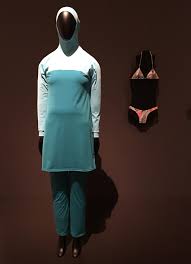‘’This, of course, is not really about swimwear. Social scientists say it is also not primarily about protecting Muslim women from patriarchy, but about protecting France’s non-Muslim majority from having to confront a changing world: one that requires them to widen their sense of identity when many would prefer to keep it as it was.’’ wrote Amanda Taub in her article ‘’France’s ‘Burkini’ Bans Are About More Than Religion or Clothing’’ (in the Publisher, Augst 18, 2016). Indeed, during the summer 2016 started a controversy about muslim women wearing burkinis on beaches in the south of France, with politicians proposing to ban it and claiming that it was an attempt against laicity, to and a symbol of women’s oppression.
But the burkini was also to be found in the Moma’s exhibit, Items, this fall in New York. This choice seems very interesting to me. Next to other pieces more ‘’artistic’’ or more ‘’fashionable’’ (such as the Chanel little black dress or the Miyake A-POC Queen Textile), and along with the kippah and the hijab for instance, it openly reminded the political, social and religious dimension of fashion and clothing. According to the mission statement of the exhibit, depicting the complex relationship of fashion with other dimensions such as ‘’functionality, culture, aesthetics, politics, labor, identity, economy, and technology’’ was the goal of the museum. By showing that fashion is not only a ‘superficial’, ‘frivolous’ thing, and by showing its anthropologic significance, the MOMA legitimize a field often looked down as well as the importance of its study. Fashion is of course a question of aesthetic and beauty ; but its role and meaning can’t be reduced to this aspect. The burkini controversy was for instance an evidence of social and political trends : the rise of islamophobia, nationalism and identity crisis in Europe and the tensions that exist between the different religious and ethnic communities in France. It also echoes to the fear that any ‘’symbol’’ of Islam may arouse in context of war and terrorism due to religious radicalization.
Next to the burkini was displayed a bikini from the 70’s. It reminded me of the sexual liberation characteristic of this period, an of the women’s right movement. The contrast between the two pieces was striking. It demonstrates the variety of practices regarding cloth in the world : while at the beach some women will display their skin by wearing a bikini other prefer to hide or protect their body entirely. This shows that a same function (a piece of cloth for swimming) will be interpreted in a different way depending on one’s culture or religion. This almost provocative way of displaying the two items may suggest the importance of giving people the freedom to dress the way they want according to their will and convictions.
